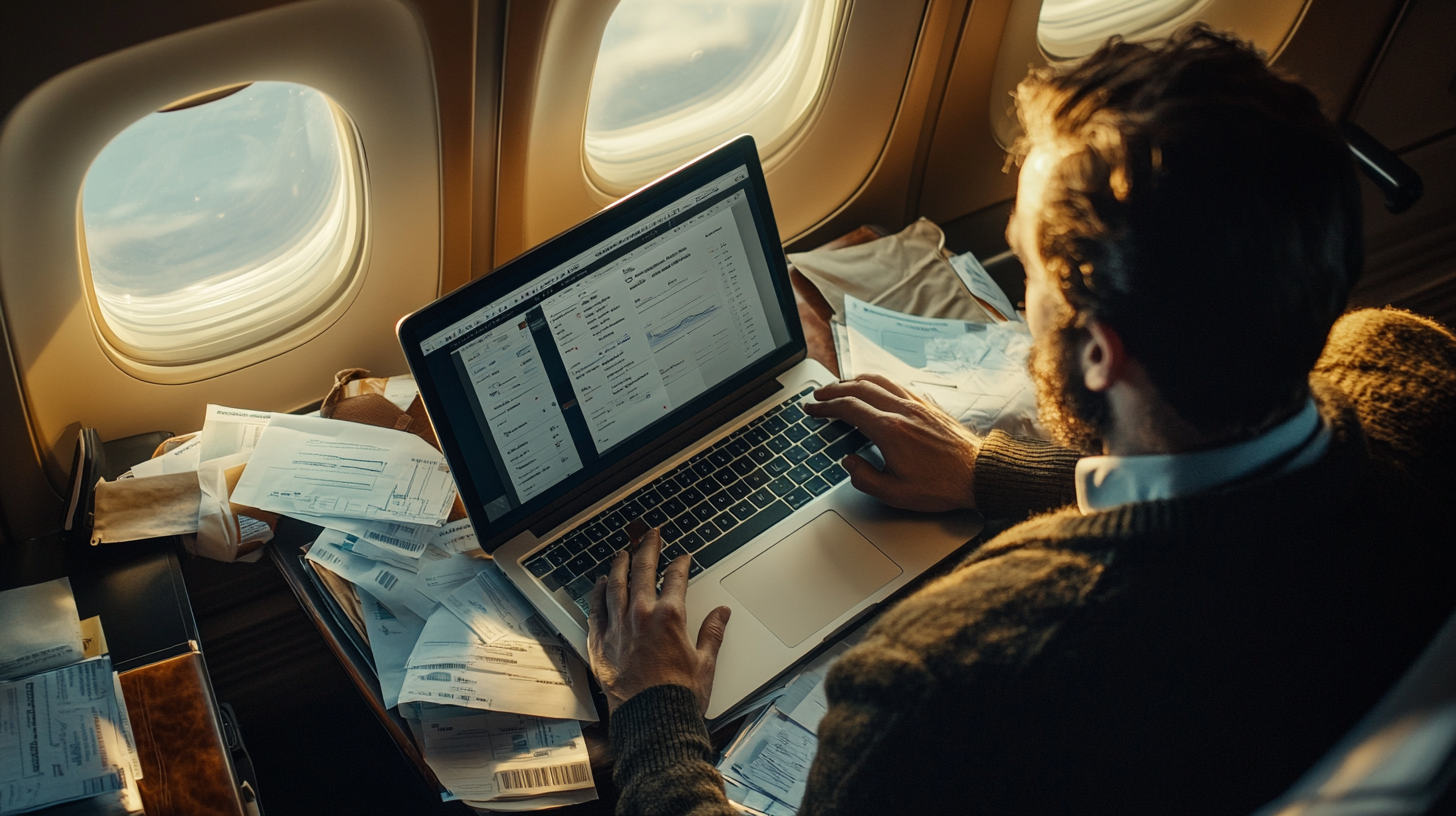Business Travel Expenses Made Easy for Frequent Flyers

I’ve always enjoyed watching the world unfold beneath me from a window seat, but I know all too well how tricky it can be to keep expense receipts and reimbursement requests in order. Over the years, I’ve refined my system for managing the flurry of paperwork each trip produces, and I’ve found that a simple yet comprehensive approach makes a huge difference. By using templates, automating processes, and sticking to disciplined tracking, business travel can become more about the journey and less about petty stress.
1) Why Travel Expense Reports Matter

In my experience, a dependable travel expense report is like a roadmap for financial clarity—it shows where money is being spent, keeps you accountable, and serves as a guide for future budget decisions. According to the Global Business Travel Association‘s 2024 forecast, corporate travel spending worldwide is expected to surge past pre-2020 numbers by 2025, which means more trips and, inevitably, more expenses to track. By detailing each cost carefully, both the traveler and the employer benefit from an organized record that helps prevent overspending and errors.
When I first started traveling for work, I learned the importance of transparency. Every flight ticket, hotel receipt, and restaurant bill serves as evidence of where the funds went, making sure reimbursement processes stay smooth. In my experience, missing a single receipt can lead to complicated audits or delays in reimbursement. To avoid these headaches, a good expense report keeps all details neatly categorized and easily retrievable.
Beyond financial accuracy, these reports can be a compliance safety net. Many companies have governance policies that require proof of expenditure, and from my perspective, it’s a relief when you have everything in one place. This vigilance also discourages mistakes in expense coding or, worse, intentional misuse. Whether you’re traveling every month or just a few times a year, taking the time to assemble clear, well-structured reports pays off.
2) Choosing the Right Template

I’ve tested quite a few templates over the years, from Google Sheets to ready-made Excel trackers. Free downloads often come with helpful pre-labeled columns for flights, lodging, meals, and miscellaneous expenses, which you can tweak to fit your needs. According to a 2023 survey by the Corporate Travel Department, employees who used structured spreadsheets experienced a 45% reduction in errors compared to those who filed expenses informally.
Some folks prefer text-based forms, like a Word document, that allow them to pop in quick notes about each trip’s purpose and date. I find spreadsheets helpful for quick sum calculations—especially if I’m adding up mileage at the end of the month—but I also appreciate a concise document for summarizing the who, what, and why of each expense in plain language. Templates come in all shapes and sizes, but the best ones strike a balance between completeness and ease of use.
In my own travels, I’ve noticed that the simpler the template, the more likely I am to stick to it. So I recommend picking something intuitive, whether it’s color-coded columns or a Word file with labeled sections. The right structure ensures you don’t miss a beat and helps your employer or finance department quickly process your reimbursement.
3) Pro Tips for Accurate Tracking

I remember the first time I got home from a multi-city journey—I had stacks of boarding passes, random coffee shop receipts, and toll tickets. After that experience, I made a habit of snapping digital photos of receipts and uploading them to a cloud folder right away. A recent study suggests that travelers who promptly digitize receipts reduce their risk of lost paperwork by up to 60%.
One of my personal hacks is using mileage reimbursement charts based on current Internal Revenue Service (IRS) rates. It’s easy to overlook car rental or mileage costs if you’re hitting multiple sites in a single trip. Label everything diligently, and if your company offers a mobile app for expenses, I recommend logging them daily. Itemized listings safeguard against mischarges, especially if a credit card gets used for both personal and business transactions.
I’ve also learned to double-check expense codes—particularly for categories like entertainment or client meals. Paying attention to these details prevents you from scrambling to justify costs when finance reviews your submission. By being consistent and thorough, you’ll keep your data accurate and your reimbursement process smooth.
4) Automating with Leading Expense Tools

Sometimes spreadsheets just aren’t enough, especially when you’re traveling frequently. I’ve turned to digital platforms like Navan, Expensify, and SAP Concur to help tame the chaos. According to the Travel Tech Association, companies that adopt automated expense tools can cut reimbursement processing times by an average of 35%. These tools allow you to upload receipts in real time, generate reports, and automate approvals.
In my own case, a mobile app that scans receipts was a game-changer. I’d simply snap a photo of my coffee bill while waiting to board, and it would sync directly with my online account. Many of these tools also integrate with accounting systems, so your expenses feed right into budgets and financial statements. If you handle frequent flights, consider using virtual cards—one of the most convenient features that let you track spending and set spending limits without needing a physical card in your wallet.
Ultimately, automation isn’t just about saving time; it’s about reducing errors, maintaining compliance, and highlighting areas of potential overspending. With AI-driven analytics becoming more sophisticated, I’ve observed that these platforms can even suggest best practices, like cheaper flight routes or budget-friendly lodging options, helping everyone in the company save.
5) The Art of the Business Travel Report

For me, a business travel report is not just about receipts—it’s also about capturing the essence of why we travel. When a trip’s purpose is clearly outlined, such as meeting a key client or attending a crucial conference, expenses make a lot more sense in context. And when you list any significant wins or learning experiences, you help paint a fuller picture of the journey’s value.
For example, I once spent a week bouncing between satellite offices, racking up a pile of receipts. Rather than just attaching those receipts, I added a brief summary about meeting new partners, finalizing a marketing proposal, and presenting at an internal workshop. These notes not only justified the expenses but also highlighted achievements that benefited my team’s goals. That kind of transparency goes a long way with leadership, especially if you’re trying to secure travel budgets for bigger opportunities in the future.
It’s also a good idea to include any suggestions for improvement or future cost savings in your report. I’ve noticed that managers appreciate practical insights, such as better flight connections, efficient ground transportation options, or guidelines for dining expenses. A well-crafted report is a reflection of both financial responsibility and professional foresight.
Final Thoughts

Business travel may require a bit of strategic juggling, but a robust expense system turns that challenge into an organized routine. From choosing an easy-to-customize template to automating processes, every step contributes to a more streamlined journey. I’ve found that thorough, honest documentation pays dividends when it comes to clarity, reimbursement, and compliance.
With corporate travel gearing up for a strong return by 2025, there’s no better time to refine your processes. Whether you’re an occasional business traveler or someone who logs 100,000 miles a year, consistent tracking and transparent reporting make life in the skies—and on the ground—so much easier.
Ryder’s Take
From my seat near the window, I’ve seen how detailed expense reporting can free you up to enjoy the flight and focus on the bigger goals of your trip. Rather than wrestling with scattered receipts and complicated forms, you’ll have room to strategize, recharge, and maybe even indulge in the inflight meal without worry.
In my opinion, it’s these little improvements—like an automated expense app or a neatly designed spreadsheet—that separate an okay trip from a fantastic one. The numbers matter, but so does the traveler’s peace of mind.






